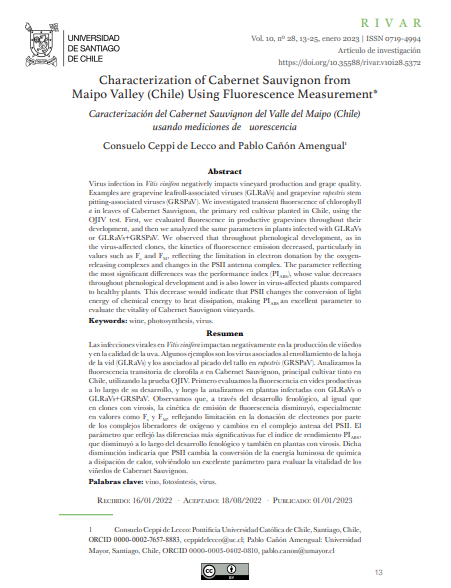Characterization of Cabernet Sauvignon from Maipo Valley (Chile) Using Fluorescence Measurement

Fecha
2023-01Autor
Ceppi de Lecco, Consuelo
Canon Amengual, Pablo [Univ Mayor, Santiago, Chile]
Ubicación geográfica
Notas
HERRAMIENTAS
Acceda a títulos restringidos
¿Cómo descargar?Resumen
Virus infection in Vitis vinifera negatively impacts vineyard production and grape quality. Examples are grapevine leafroll-associated viruses (GLRaVs) and grapevine rupestris stem pitting-associated viruses (GRSPaV). We investigated transient fluorescence of chlorophyll a in leaves of Cabernet Sauvignon, the primary red cultivar planted in Chile, using the OJIV test. First, we evaluated fluorescence in productive grapevines throughout their development, and then we analyzed the same parameters in plants infected with GLRaVs or GLRaVs+GRSPaV. We observed that throughout phenological development, as in the virus-affected clones, the kinetics of fluorescence emission decreased, particularly in values such as F-o and F-M, reflecting the limitation in electron donation by the oxygen-releasing complexes and changes in the PSII antenna complex. The parameter reflecting the most significant differences was the performance index (PIABS), whose value decreases throughout phenological development and is also lower in virus-affected plants compared to healthy plants. This decrease would indicate that PSII changes the conversion of light energy of chemical energy to heat dissipation, making PIABS an excellent parameter to evaluate the vitality of Cabernet Sauvignon vineyards.
URI
https://repositorio.umayor.cl/xmlui/handle/sibum/9485https://www.scielo.cl/pdf/rivar/v10n28/0719-4994-rivar-10-28-13.pdf
http://dx.doi.org/10.35588/rivar.v10i28.5372
Coleccion/es a la/s que pertenece:
Si usted es autor(a) de este documento y NO desea que su publicación tenga acceso público en este repositorio, por favor complete el formulario aquí.